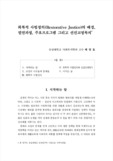

-
 * 본 문서는 배포용으로 복사 및 편집이 불가합니다.
* 본 문서는 배포용으로 복사 및 편집이 불가합니다.
미리보기
서지정보
· 발행기관 : 한국교정학회
· 수록지 정보 : 矯正硏究 / 37권
· 저자명 : 배임호
목차
회복적 사법정의(Restorative Justice)의 배경, 발전과정, 주요프로그램 그리고 선진교정복지
Ⅰ. 시작하는 말
Ⅱ. 교정의 이슈들과 문제들: 국외ㆍ국내의 관점에서
Ⅲ. 회복적 사법정의 (Restorative Justice)
Ⅳ. 회복적 사법정의와 선진교정복지
Ⅴ. 마치는 글
참고문헌
Abstract영어초록
The history of correction depends heavily upon ‘how the people understand a crime and criminal offender’ in a society or country. The current criminal justice system overseas as well as domestically is fundamentally based on retribution or the justice model in its practice. Researches have pointed out that typical model has shown its limitations and problems including the lack of correctional effectiveness, astronomical amount of correctional expenses, overcrowding issues, and others. These issues and problems of the current justice system are the starting points to think differently about ways of dealing with criminal issues and the parties affected by crimes such as a crime victim, the offender, their families, and their community. Since the early 1970s, restorative justice has gained significant attention in North America, and now in many countries in Oceania, Europe, Africa, and Asia. In 2000, the United Nations Congress on Crime Prevention developed a draft proposal for UN Basic Principles on the Use of Restorative Justice Programs in Criminal Matters, which encourages the use of restorative justice by UN members. This international recognition is a huge step forward toward the international recognition of the new paradigm in criminal justice procedure. This article examines the background, developing process, and main programs, such as Victim Offender Mediation, Family Group Conferencing, and Circles. Some thoughts about advanced correctional welfare have also been presented.참고자료
· 없음태그
-
자료후기
-
자주묻는질문의 답변을 확인해 주세요

꼭 알아주세요
-
본 학술논문은 (주)코리아스칼라와 각 학회간에 저작권계약이 체결된 것으로 AgentSoft가 제공 하고 있습니다.
본 저작물을 불법적으로 이용시는 법적인 제재가 가해질 수 있습니다. -
해피캠퍼스는 구매자와 판매자 모두가 만족하는 서비스가 되도록 노력하고 있으며, 아래의 4가지 자료환불 조건을 꼭 확인해주시기 바랍니다.
파일오류 중복자료 저작권 없음 설명과 실제 내용 불일치 파일의 다운로드가 제대로 되지 않거나 파일형식에 맞는 프로그램으로 정상 작동하지 않는 경우 다른 자료와 70% 이상 내용이 일치하는 경우 (중복임을 확인할 수 있는 근거 필요함) 인터넷의 다른 사이트, 연구기관, 학교, 서적 등의 자료를 도용한 경우 자료의 설명과 실제 자료의 내용이 일치하지 않는 경우
“矯正硏究”의 다른 논문도 확인해 보세요!
-
치료도우미견 프로그램이 소년수용자의 공격성 감소에 미치는 효과에 관한 연구 (천안소년교도소 수용자를 중심으로) 34 페이지
-
Restorative Justice Policies & Programs 31 페이지
-
Restorative Justice Dialogue : Three Decades of Victim Offender Mediat.. 31 페이지
-
비행청소년 교정교육의 대안적 해결방안에 관한 연구 26 페이지
-
가석방제도 개선방안에 관한 연구 26 페이지
가석방제도가 형사정책적으로 혹은 행형에서 중요시되고 동시에 가족과 사회와 격리되어 24시간 교도소에서 생활하는 수형자들이 실제로 가장 관심을 가지는 것일 정도로 현대의 형벌개혁의 '최대의 발명품'으로 찬사를 받고 있는 것임에도 불구하고 요건을 엄격하게 제한하여 그 도입취지와 활용도를 높이지 못하고 소극적 자세로 머물고 있다 가석방제도가 가진 형사정책적 가치..
문서 초안을 생성해주는 EasyAI

